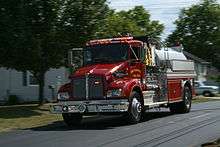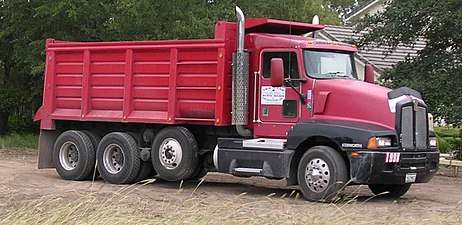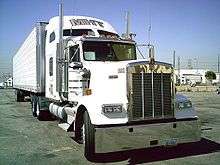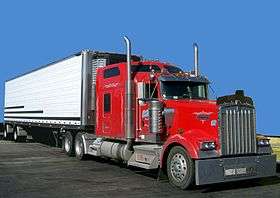Kenworth
Kenworth Trucks, Inc. is an American-based truck manufacturer. Founded in 1923 as the successor company to Gerlinger Motors, Kenworth specializes in production of heavy-duty (Class 8) and medium-duty (Class 5-7) commercial vehicles. Headquartered in Seattle suburb Kirkland, Washington, Kenworth has been a wholly owned subsidiary of PACCAR since 1945[1], operating alongside sister company (and marketplace rival) Peterbilt Motors.
Kenworth "KW" emblem and name badge | |
Formerly | Gerlinger Motors |
|---|---|
| Division | |
| Industry | Manufacturing |
| Founded | 1923 |
| Headquarters | Kirkland, Washington United States |
Key people | George T. Gerlinger, founder |
| Products | See listing |
| Parent | Paccar |
| Website | www.kenworth.com www.kenworth.com.au |
Kenworth marked several firsts in truck production; alongside the first truck produced with a standard diesel-fuel engine, the company introduced a raised-roof sleeper cab, and the first heavy-duty truck with an aerodynamically-optimized body design.[2] The Kenworth W900 was produced continuously from 1961 to 2019, serving as one of the longest production runs of any vehicles in automotive history.
History
Kenworth was founded in 1912 by brothers George T. and Louis Gerlinger, Jr. as a car and truck dealership known as Gerlinger Motors in Portland, Oregon.[3] In 1914, they decided to build their own truck with a more powerful inline six-cylinder engine, the first put into a commercial truck. The Gersix, as it was known when introduced in 1915, was framed in structural steel, which along with its power, made the truck ideal for logging[4] in the rugged Northwest.[5] In 1916 the company moved to Tacoma, Washington, where Seattle businessman Edgar K. Worthington was managing his mother's commercial building. He became intrigued by the Gerlinger company, which was doing quite well, or so it seemed, as the Gersix became a popular fixture in the Northwest.[6] In 1917 Worthington and his business partner Captain Frederick Kent bought the business, renaming it the Gersix Motor Co.[6]
In 1919 Kent retired from the business, and his son Harry Kent became Worthington's new partner.[6] In 1922, Gersix made 53 trucks at its factory on Fairview Avenue at Valley Street. Under the new name, the company moved to 506 Mercer Street and later to 1263 Mercer Street. Trucks and motor coaches were assembled in individual bays rather than on a conventional assembly line.[7] In 1923 Kent and Worthington reincorporated the business as the Kenworth Motor Truck Company, a combination of the names "Ken"t and "Worth"ington. In 1926 they started making buses, and in 1933 Kenworth was the first American company to offer diesel engines as standard in their trucks.[6] In 1945 Kenworth was bought by The Pacific Car and Foundry Company.
The 1970s television series "Movin On" featured a Kenworth tractor, as did “BJ and the Bear”. In the 1989 James Bond movie Licence to Kill, Bond drives a Kenworth W900B semi-truck as he duels drug dealer Franz Sanchez. The maximum legal load is 80,000 pounds (36,000 kg).
Current models
United States/Canada
As of August 2016, North American Kenworth models include the T680 (60% of new sales), T880 (near 30%), T660, T800B and W900 (sharing the remaining ~10%).[8]
Current products
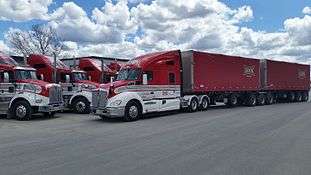
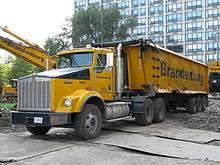
As of November 2015, Kenworth's US and Canada product line includes:
- Class 8 Conventional
- T680
- T880
- ICON900, a limited-edition premium version, introduced in 2015.
- W990
- T800, and its variants:
- T800H, a High Hood variant;
- T800W, which bears a wider grille, to accommodate a bigger radiator, for severe on-highway applications.
- C500B (Off-Highway)
- Medium-Duty Conventional
- T470 (Class 7)
- T440 (Class 7)
- T370 (Class 7)
- T270 (Class 6)
- T170 (Class 5)
Medium-Duty Cabovers
- K270 (Class 6)
- K270E (Class 6)
- K370 (Class 7)
- K370E (Class 7)
Discontinued products
- Class 8 Conventional
- T600/T600A/T600B (1985-2006, replaced by the T660)
- T450
- C850
- T660 (2008-2017, discontinued due to the sales success of the T680)[9]
- T700 (2011-2014, due to the sales success of the T680)
- T2000 (1996-2010, replaced by the T700)
- LW900
- W925 truck
- W900, and its variants:
- W900A
- W900B
- W900L
- W900S
- K100/K100E/K136E
- K184
- K330
- L700 (now Peterbilt 320)
- LCF (210)
- 993
Medium-Duty Conventional
- T300
Medium-Duty Cabovers
- Mid-Ranger series 13-210/22-210 in 1980s and K130/K220/K300 in 1990s
- K300 (also known as Peterbilt 270)
Mexico
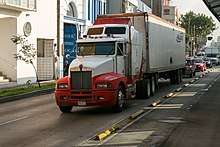
In the early 2000s Kenworth introduced to Mexico the T604, based on the Australian T604 with a few modifications, mostly in the hood.
Australia
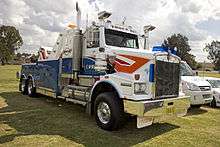
The headquarters for Kenworth Australia is located in Bayswater, Victoria where all Australian models are assembled. The first Kenworth model in Australia was the KWS925, imported fully built in 1962. Soon later, Kenworths were imported in complete knock-down kits and assembled in Preston, Victoria.[10] Australian built Kenworth models are also exported to nearby RHD markets in New Zealand, Japan, Thailand and Papua New Guinea. Popular models include the T600, T601, T604, T608, T609, T610, T610SAR, T650,T658, T659, W925, T900, T904, T908, T909, T950, T350, T359,T360, T400/T401/404S/T404ST/404SAR, K124, K100E, K100G, K104, K104B,K108, K200 (COE) and C500, C501, C508, C509, C510 and C540. The T range includes the bonneted conventional models and the C for heavy haulage, mining, off-road and road train use, and the K range covers the cab over models. As of July 2020 the only models that do not have Twin-Steer configurations are T410 SAR, T610 SAR, T900, C510, C540.
Kenworth Australia started building the new range of trucks tying in their 2008 release with the model range being the '08 Series'. This includes the following conventional (bonneted) models; in approximate order of smallest to largest: the T358/A, T408SAR, T408, T608, T658, T908 and C508. The only cab over truck built was the K108, which was very popular in the B-Double market segment owing to its shorter length.
Current Australian Kenworth models include:
T Series - T360, T410, T410 SAR, T610, T610 SAR, T659, T909
C Series - C509, C510, C540
K Series - K200
Bus industry
1926–1933
BU series
- Bus production was a mainstay at Kenworth for much of the company's early years, and at one time was the company's most lucrative form of business. When the company was known as Gerlinger Motor Car Works, their first two full-chassis vehicles were school buses based on the Gersix truck chassis. In 1926, Kenworth developed a chassis specifically for school and transit bus operators, known as the BU. The BU model sported a wheelbase of 212 inches (5,400 mm) that was expanded two more inches in 1927, and could be fitted with bodies ranging from 21 to 29 passengers. The BU model also heralded the return of the Buda six-cylinder engine, and remained the company's principal offering through 1931. The new model became so popular in the Pacific Northwest that production rose from 99 units in 1927 and 127 units in 1927, to 230 units by 1930. By that time, the predominant number of BU models produced were sent to school bus body builders, and were built for use in school districts throughout the Seattle and Puget Sound area of Washington state.
KHC series
- Kenworth continued expanding into bus production throughout the 1930s, despite the Great Depression being a major influence. To assist Kenworth's 80 factory workers - who were idled by the Depression, the company undertook a bold move by introducing a new line of buses in August 1932. Known as the KHC-22 (Kenworth - Heiser - City), the 23-passenger bus was developed by Kenworth engineers as a stock demo vehicle to help aid a glum sales picture, and to jumpstart the local economy. At a time of mild economic recovery, the KHC22 proved to be very popular and sparked a renewed interest in Kenworth buses. Major operators of the KHC-22 (later expanded to a 225-inch (5,700 mm) wheelbase, 33-passenger KHC-33, in September 1933) were the Portland Railway, Light & Power Company of Portland, Oregon, and Spokane United Railways.
1933–1939
- In that year, Kenworth also released its most popular and successful line of transit bus, a conventional styled bus based on their Model 86 heavy duty truck. Powered by a Hercules JXCM engine, the model 870 as it was known, would soon be replaced by a model 871, which became Kenworth's standard line of buses throughout the early and mid-1930s. Experiments with "deck-and-a-half" buses would soon follow, made reality in the W-1 model, as well as the company's very first experiments with rear-engine coach-type buses in 1936.
- Production of Kenworth buses continued throughout the 1930s and into the early 1940s, and during this time Kenworth was manufacturing bus chassis for body builders such as Wentworth and Irwin (later renamed Wentwin), and Heiser. Heiser, long an often chosen body for school buses bearing Kenworth chassis, would later be purchased by Pacific Car and Foundry Company in 1937.
- Kenworth changed its production line early in 1939, reflecting a desire to remain "in tune" with market forces. The conventional bus chassis, which had become poor sellers, were dropped altogether, and Kenworth focused its designs on more transit or "coach-type" buses with engines being located either underfloor or at the back of the bus.
- By this time, Kenworth was a major force in transit bus production, and nearly every major transit company in the Pacific Northwest were running Kenworth buses. Seattle Municipal Railway purchased several new model 601s to replace the previous model H30s, which were powered by a Hall-Scott 135 engine underfloor and had bodies built by the Pacific Car and Foundry Company. Kenworth also built a model 612, which became the company's most widely distributed underfloor coach. 27 were built with 14 wheelbase variations (and seven engine variations), and all 27 were sold by as many as 15 different operators.
1940–1959
- At the onset of World War II, Kenworth's bus production waned again, but Kenworth was able to remain afloat because orders were now larger than before. This was possible because the early effects of the war forced the amalgamation of several smaller, more regional operators into larger, territorial ones. These conditions meant more bus orders for Kenworth, only there were fewer buyers. Bremerton Transit purchased several buses in 1940 to accommodate the increase in ridership due to the preparations for the war itself.
- In the face of these conditions, Kenworth still maintained production at about 40 units annually. In 1940, the Seattle Municipal Railway purchased 30 buses in a single order, assisting Kenworth in breaking a production record. With low volume production, Kenworth was more than willing to build special order coaches. Gray Line affiliates Seattle, Portland, and Vancouver purchased several of these special coach orders known as Grayliner or Grayliner Junior buses, and the bodies for these buses were all built by PC&F. When wartime ensued, Kenworth found itself once again focusing its efforts towards war production, producing troop transports and a number of military variations of their commercial truck line.
- Near the end of World War II, the company would become part of the Pacific Car and Foundry Company. In 1944, the passing of Kenworth president Philip G. Johnson meant that the major stockholders, the widows of Johnson, and Kenworth founders Kent and Worthington - could sell their controlling shares and stake of the company. Foreseeing a drastic downturn at war's end, Kenworth and PC&F believed bus production would play a pivotal role in jumpstarting the economy. It also saw an opportunity to hire former military truck and aircraft workers, and began a major push of four primary postwar models set to be relaunched in 1946.
- The postwar Kenworth buses were part of a small group that included small intercity or interurban buses, dubbed the model K; a trolley coach known as the model E; a city transit bus known as the model N; and a model W - an intercity bus. The choice of model designations derived from the first four letters of the name KENWorth. Later on, a one-door transit bus dubbed the Model O and a prototype school bus dubbed the model T,[11] which was the early forerunner of nearly 3000 model CT and LR buses produced by Kenworth from 1949 to 1957. Ultimately, the company built trolley buses for just one city – a single order of 50 of model E2 built in 1947–48 for the Portland Traction Company, in Portland, Oregon.[12][13]
K & W series
- The Model K and Model W buses looked quite similar, but all similarities ended there. The differences were their length, side window design, and the choices of available engines. The model W had a pancake underfloor Hall-Scott 190 engine, while the K was powered by an International Red Diamond RD450 in the rear of the bus. The shorter model K was capable of hauling 25-33 passengers, while its bigger brethren could haul anywhere between 31 and 41 passengers depending on configuration. The Model N, as announced, would have seated 36 to 44 passengers in an underfloor engine configuration, but in 1947 it was downsized to a 32 to 36 passenger bus when the original design found no takers. After 1947, Kenworth began assigning numerals to the model designations to signify evolutionary variants in the design.
- As production orders for the interurban model Ks and model Ws waned, Kenworth focused its attention on special orders including an order of 10 "Brucks"[14] for Great Northern Railway in Montana, (an earlier version was built for Northern Pacific Transport, but was a split-level coach) and several Highway Post Office coaches. These "special order coaches" were based on the model T school bus, which entered production in early 1949, after additionally test-marketing a small 20-passenger bus known as the Carcoach (only one was built, but none entered full production).
T & C series
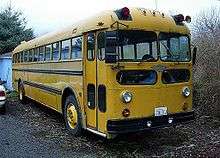
- The Model T school bus, which entered production after the last bus was built for Great Northern in April 1949, was an immediate hit with many school bus operators in the Pacific Northwest. The T-126 as it was known, boasted a unique four-pane windshield that offered unheralded forward visibility in any school bus at the time, and was the first school bus ever built to feature a roof escape hatch[15] (now required equipment). Production of the T-126 averaged over 375 buses per year, making it Kenworth's most lucrative bus offering in the company's history up to that time. Shortly after its launch, Kenworth renamed the line the model CT. The model CT also came in several varying passenger capacities ranging from 55, 61, 67, 73, and 79 passengers. The model CT "Pacific School Coach" was powered by an International Red Diamond 450 inline six-cylinder gas engine placed at the rear of the bus, and a LeRoi H540 engine was made available for an LR-73 model that was produced in August 1950. Some orders for modified model CTs were made available and sold internationally, with variants being sold to Uruguay and Venezuela, as well as the Middle East.
- After the boon of school bus production, and to focus more on truck production due to a rising number of heavy duty truck orders, all bus production was shifted from Kenworth over to Pacific Car and Foundry in the middle of 1956. After some final cleanup, PC&F wound up completely outstanding orders for the Pacific School Coach in early 1957. Shortly afterwards, PC&F sold all rights, tooling, and equipment to Gillig Bros., a school bus manufacturer based in Hayward, California. Gillig would later incorporate many designs of the model CT "Pacific School Coach" into their own Transit Coach line of school buses, starting with the 501- and C-series models in 1958 and 1959, respectively.
Bus industry legacy
Kenworth's role in the transit and school bus industry has largely been forgotten. This is likely due to a number of factors including Kenworth's current status as a leading manufacturer of Class 8 heavy-duty semi trucks, and the fact that hardly any examples of Kenworth-built buses exist today (with exception of a few surviving model CT-73 "Pacific School Coach" buses and one remaining "Bruck").
In light of that fact, and having been a major builder of transit and school buses, interest in the history and preservation of the Pacific School Coach (as well as Kenworth's involvement in the transit and bus industry as a whole) has increased in recent years, especially in the Pacific Northwest where Kenworth's buses were most commonly found. The Gillig Transit Coach / Pacific SchoolCoach Online Museum, a website focusing on preserving Gillig's line of earlier-built school buses, was expanded shortly after its 2001 launch to include the history of the Kenworth-Pacific SchoolCoach. It has since expanded even further to include the entire history of Kenworth's involvement in the public transportation industry, as well as their local dominance in the school bus industry throughout the 1950s.
In 2006, at the American Truck Historical Society's 11th Annual Truck Show at the Mason County Fairgrounds in Shelton, WA, a historical society dedicated to preserving the Gillig Transit Coach and Kenworth-Pacific School Coach was officially dedicated.
Reception
The brand claims to maintain an image of high quality, it has won five of six JD Power Awards in 2005, and was a clear sweep in the 2007 J.D. Power Awards for Heavy Duty Truck Product Satisfaction.[16]
Operations
Kenworth currently has manufacturing plants in Chillicothe, Ohio, Renton, Washington, Sainte-Thérèse, Quebec, Canada, Bayswater, Victoria, Australia - Kenworth Australia, and Mexicali, Baja California, Mexico.
Gallery
See also
- Paccar
- Peterbilt (Kenworth's sister company in Paccar)
- DAF Trucks
- Murphy-Hoffman Company (Largest US Kenworth Dealership)
- Gillig Corporation
- Class 8 Trucks
- Semi-trailer truck
- Dump Truck
References
- "About Us | PACCAR". www.paccar.com. Retrieved 2020-07-24.
- "Kenworth Trucks - The World's Best ®". www.kenworth.com. Retrieved 2020-07-24.
- "History of Kenworth Trucks". Retrieved 24 July 2020.
- Great Trucks
- Starner, D. Earl. A Pictorial History of the Straddle Carrier, 1988. 48p.
- Kenworth History Archived 2007-10-02 at the Wayback Machine - at Kenworth.com
- "Kenworth Motor Truck Corporation incorporates in Seattle in January 1923". Retrieved 9 July 2018.
- "Kenworth enhancing day cabs, ending T660". Today's Trucking. August 13, 2016. Retrieved August 26, 2016.
- "Kenworth To Say Farewell To Venerable T660". PACCAR press release. August 16, 2016. Retrieved August 26, 2016.
- "Kenworth's Road to Australia". TruckWorld.com.au. 2 February 2007. Retrieved 13 April 2015.
- Pacific Photos - at Gillig Coaches Archived January 18, 2007, at the Wayback Machine
- Murray, Alan (2000). World Trolleybus Encyclopaedia, p. 123. Yateley, Hampshire, UK: Trolleybooks. ISBN 0-904235-18-1.
- Sebree, Mac; and Ward, Paul (1973). Transit's Stepchild: The Trolley Coach, p. 217. Los Angeles: Interurbans. LCCN [].
- KW Bruck - at Gillig Coaches Archived September 28, 2007, at the Wayback Machine
- Pacific Trivia - at Gillig Coaches Archived March 14, 2007, at the Wayback Machine
- "Archived copy". Archived from the original on 2008-02-09. Retrieved 2008-01-25.CS1 maint: archived copy as title (link)
External links
- Kenworth Truck Company
- Kenworth Truck Australia
- Kenworth Truck Mexico
- The Kenworth W-1 Deck and a Half Bus
| Wikimedia Commons has media related to Kenworth. |
